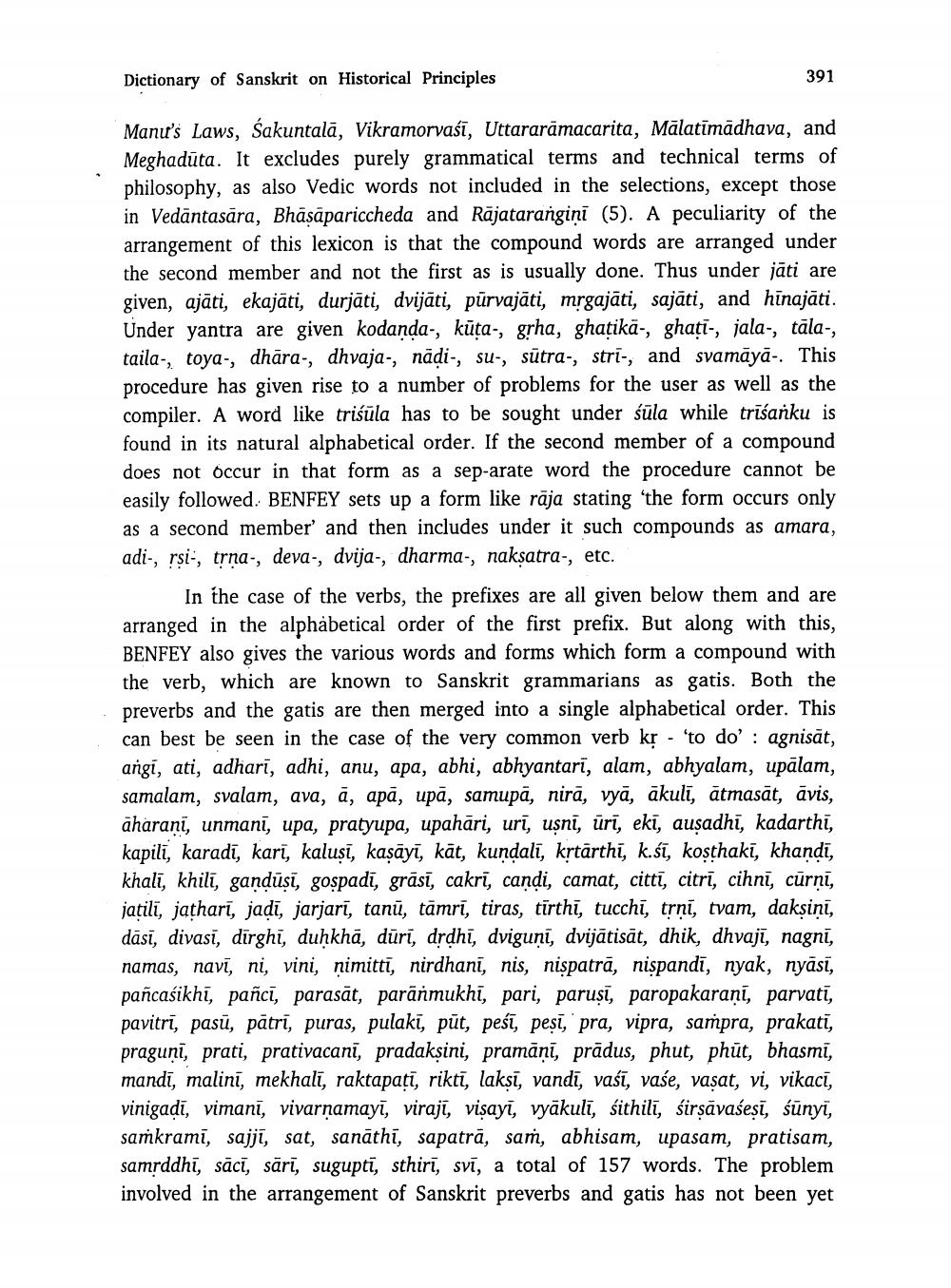________________
Dictionary of Sanskrit on Historical Principles
391
Man's Laws, sakuntalā, Vikramorvašī, Uttararāmacarita, Mālatīmādhava, and Meghadūta. It excludes purely grammatical terms and technical terms of philosophy, as also Vedic words not included in the selections, except those in Vedāntasara, Bhāsāpariccheda and Rājatarangini (5). A peculiarity of the arrangement of this lexicon is that the compound words are arranged under the second member and not the first as is usually done. Thus under jāti are given, ajāti, ekajäti, durjāti, dvijāti, pūrvajāti, mrgajāti, sajāti, and hinajāti. Under yantra are given kodanda-, kūţa-, grha, ghatikä-, ghati-, jala-, tāla-, taila-, toya-, dhāra-, dhvaja-, nādi-, su-, sūtra-, stri-, and svamāyā-. This procedure has given rise to a number of problems for the user as well as the compiler. A word like trisüla has to be sought under śūla while trīšarku is found in its natural alphabetical order. If the second member of a compound does not occur in that form as a sep-arate word the procedure cannot be easily followed. BENFEY sets up a form like rāja stating the form occurs only as a second member and then includes under it such compounds as amara, adi-, rsi-, trna-, deva-, dvija-, dharma-, nakṣatra-, etc.
In the case of the verbs, the prefixes are all given below them and are arranged in the alphabetical order of the first prefix. But along with this, BENFEY also gives the various words and forms which form a compound with the verb, which are known to Sanskrit grammarians as gatis. Both the preverbs and the gatis are then merged into a single alphabetical order. This can best be seen in the case of the very common verb kr - 'to do': agnisāt, angi, ati, adharī, adhi, anu, apa, abhi, abhyantarī, alam, abhyalam, upālam, samalam, svalam, ava, ā, apā, upā, samupā, nirā, vyā, ākulī, ātmasāt, āvis, āharani, unmanī, upa, pratyupa, upahāri, urī, ușni, ūrī, eki, ausadhi, kadarthi, kapili, karadī, karī, kaluşī, kasāyī, kāt, kundalī, krtārthi, k.śī, kosthaki, khandi, khalī, khilī, gandūși, gospadi, grāsī, cakrī, candi, camat, cittī, citrī, cihnī, cūrņi, jatili, jatharī, jadi, jarjari, tanū, tāmrī, tiras, tīrthi, tucchi, trni, tvam, daksini, dāsi, divasi, dirghi, duḥkhā, dūrī, drdhi, dviguni, dvijātisāt, dhik, dhvaji, nagni, namas, navi, ni, vini, nimitti, nirdhani, nis, nispatrā, nispandi, nyak, nyāsi, pañcaśikhī, pañcī, parasāt, parāňmukhī, pari, paruṣī, paropakarani, parvati, pavitrī, pasū, pātrī, puras, pulaki, pūt, peśī, peși, pra, vipra, sampra, prakati, pragunī, prati, prativacani, pradaksini, pramāni, prädus, phut, phūt, bhasmī, mandi, malini, mekhali, raktapati, riktī, lakṣī, vandī, vašī, vase, vaşat, vi, vikacı, vinigadi, vimanī, vivarṇamayi, viraji, visayi, vyākulī, śithilī, śirşāvašeși, śūnyi, saṁkramī, sajji, sat, sanāthī, sapatrā, saṁ, abhisam, upasam, pratisam, samrddhi, sācī, sārī, sugupti, sthirī, svī, a total of 157 words. The problem involved in the arrangement of Sanskrit preverbs and gatis has not been yet




